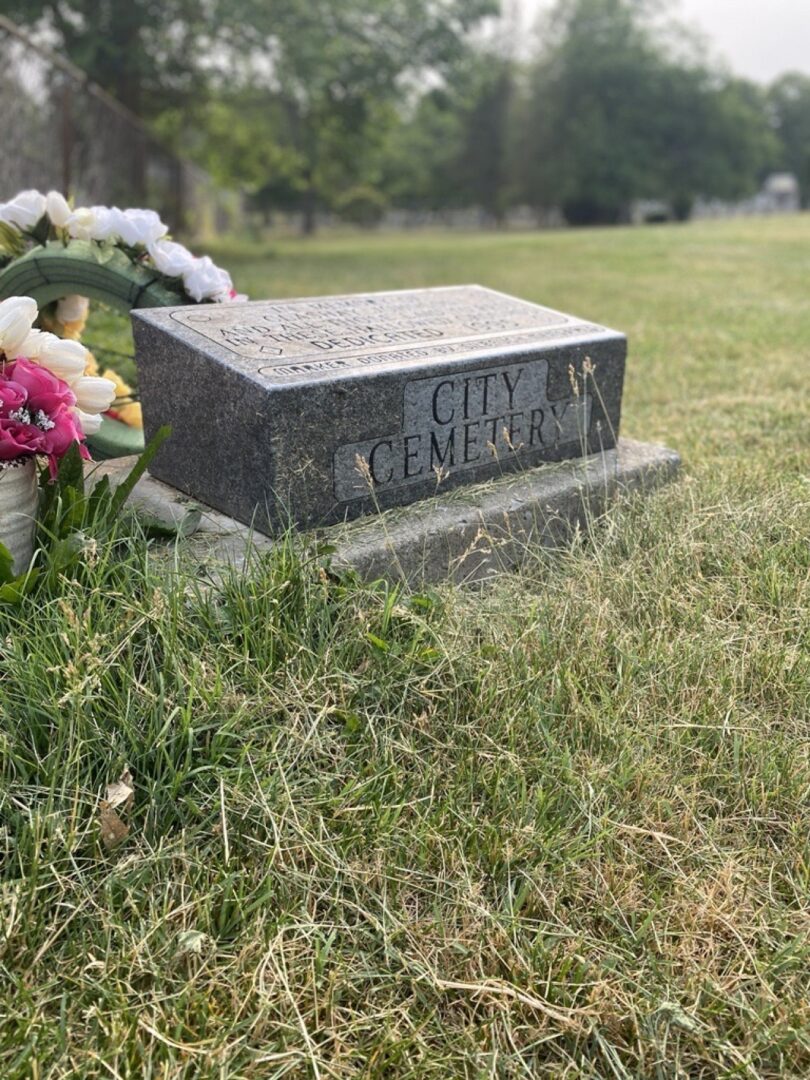
The only grave that is marked at York City Cemetery belongs to Clashay Johnson, who died when he was a child.
Gabriela Martinez / WITF

The only grave that is marked at York City Cemetery belongs to Clashay Johnson, who died when he was a child.
Gabriela Martinez / WITF

Gabriela Martinez / WITF
The only grave that is marked at York City Cemetery belongs to Clashay Johnson, who died when he was a child.
A group called Project Penny Heaven wants people to know that a grassy field next to Prospect Hill cemetery in York is the site of hundreds of unmarked graves.
So it turned to a group of 18 history students at York College looking to improve their research skills.
Their work is now an exhibit at York College’s Center for Community Engagement. It reveals details of the lives of some of the roughly 800 people buried there.
A timeline of the cemetery notes key dates starting from the 1700s. An article in the York Gazette published in 1894 indicates that Hessian soldiers, German mercenaries who fought for Britain in the American Revolution, are buried there.
In 1816, John R. Coates sold the potter’s field plot to the city of York. In 1887, the York School District bought the site for development, so roughly 600 bodies were moved to the current site along Schley Alley. In the 1920s, the case of a mother who couldn’t find her child’s remains raised awareness about the need to map out the burial spots. The site officially became York City Cemetery in 1974.
That was where the city buried the poor or those who had no family members to take care of their remains. The only gravestone belongs to Clashay Johnson, a Black boy who died in the 1980s.
Historian and York College professor Jacqueline Beatty assigned each student 10 to 15 people to research. Students used online newspaper archives, obituaries and information previously gathered by Jamie Noerpel, chair of Friends of York City Cemetery, and other Project Penny Heaven volunteers.
For Sydney Slack, a rising senior studying forensic chemistry and history, her research showed that many of those buried were once active in their community, but died alone. The old newspaper articles Slack collected often included a callout to possible family members who could claim the person’s body.
One person, William Wilson, died at 74 from a “coronary occlusion” in 1938. He had lost touch with his sister decades earlier when he left his hometown of Boston to join the circus. The policemen who searched his home after he died found a letter addressed to the mayor of Boston asking him to help search for his sister.
“They didn’t necessarily have any family or very close friends to take care of the arrangements. I don’t know that it was necessarily a matter of costs, like it had originally been presented,” Slack said.
Alaina Crowell, majoring in public history, dug into the lives of an interracial couple. Catherine Fuller, who was White and whose maiden name was Brooks, was married to Charles Fuller, who was Black. They both died in the 1930s. Crowell found that the couple were buried in plots that were far apart, but she was unable to determine why.
The exhibit also examines how newspaper reports could shape the perception of people buried at the potter’s field.
The students looked at newspaper articles from the late 1890s to the early 1930s. Among them, for example, they found a York Daily Record report about a Fiji man bought by P.T. Barnum. The so-called “Fiji cannibal” died in York in 1872. The man, who was traveling as part of a racist sideshow act, was described in articles as a “little savage” and a “cannibal dwarf.”
One account claims that his troupe companion attempted to eat him when he died, but that account was later debunked by another local publication. The man was buried in the original site of the potter’s field, but his body was lost when the city moved the field to a new site.
“I could feel a real tension between the families and the records in the city, and the way they were displaying – and not displaying – the history of the people that are buried there. It was just more unsettling,” Crowell said.
Project Penny Heaven reached its $20,000 goal to commission a monument to honor the people buried at York City Cemetery. However, due to inflation and the rising cost of materials, the group might have to continue to fundraise. They hope to have all the names sandblasted onto the monument, but Noerpel says she is still uncovering names of people as she digs through newspaper archives.
“It is primary research, and it’s in the process of being done. It’s not finished,” Noerpel said. “I think a lot of people think that history is done and over with and we’re just retelling the same stories, but we’re not. This is brand new information that we’re uncovering.”

A collection of interviews, photos, and music videos, featuring local musicians who have stopped by the WITF performance studio to share a little discussion and sound. Produced by WITF’s Joe Ulrich.
The days of journalism’s one-way street of simply producing stories for the public have long been over. Now, it’s time to find better ways to interact with you and ensure we meet your high standards of what a credible media organization should be.